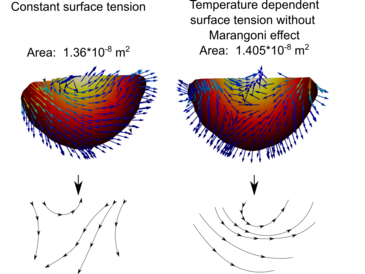Florian Wirth, Teresa Tonn, Markus Schöberl, Stefan Hermann, Hannes Birkhofer and Vasily Ploshikhin
Modelling Simul. Mater. Sci. Eng. 30, 034001 (2022)
Tangential surface tension forces on a gas–liquid interface due to surface tension gradients have been implemented in the computational fluid dynamics (CFD) solver icoReactingMultiphaseInterFoam provided by the open-source software environment of OpenFOAM OpenCFD Ltd (ESI Group) OpenFOAM (online) https://www.openfoam.com/ (accessed 21 May 2021), so that the Marangoni effect can be taken into account, which is a main driver of heat transfer in additive manufacturing processes that comprise a melt pool. The solver surpasses the capabilities of similar open-source projects by considering a wide range of physical effects, e.g. multiple phases, melting, solidification, evaporation, and laser beam heat sources with an arbitrary intensity distribution and thus makes it an appealing framework, especially for the simulation of the laser powder bed fusion (LPBF) process. Herein, all relevant details and derivation considering the Marangoni effect are provided and validated by means of a benchmark problem by comparing the obtained results with the available analytical solution, with the results obtained from a commercial CFD tool and with the results of other authors. The modified solver is additionally validated by comparing the results from LPBF simulations with experimental data. Furthermore, the influence of the surface tension modeling on the mushy region is investigated. The optimized implementation shows improvements of the simulation results in both the dimensions and shape of the melt pool and the resulting surface with regard to the experimental data.

![[Translate to English:]](/fileadmin/user_upload/sites/bccms/images/logos/bccms-logo-2022-subline-padded-up.png)
